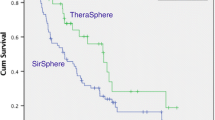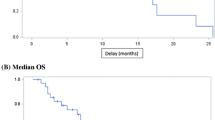Abstract
Objective
The aim of this study was to assess the early therapy response in patients with unresectable CCA who received Y-90 microsphere therapy for CCA and define the factors related to therapy response.
Materials and methods
Data of 19 patients [extrahepatic (n: 6) and intrahepatic (n: 13)] who received 24 sessions of Y-90 microsphere therapy [glass (n: 13) and resin (n: 11)] were retrospectively evaluated. Tumor load, tumor size, therapy response evaluation by RECIST1.1 criteria (n: 13), tumor lesion glycolysis (TLG), metabolic tumor volume (MTV), and metabolic therapy responses were evaluated (n: 8) using PERCIST1.0 criteria.
Results
No significant relation was found between therapy response and tumor localization, treated liver lobe, type of Y90 microspheres, the presence of previous therapies, perfusion pattern on hepatic artery perfusion scintigraphy, or patient demographics. The mean overall survival (OS) was 11.9 ± 2.3 months and was similar after both resin and glass Y90 microspheres; however, it was longer RECIST responders (p: 0.005). MTV and TLG values significantly decreased after therapy, and ΔMTV (− 45.4% ± 12.1) was found to be positively correlated with OS. No statistical difference was found between iCCA and eCCA, in terms of OS and response to therapy. Although not quantitatively displayed, better-perfused areas on HAPS images had a better metabolic response and less perfused areas were prone to local recurrences.
Conclusions
Both resin and glass microsphere therapy can be applied safely to iCCA and eCCA patients. Early therapy response can be evaluated with both RECIST and PERCIST criteria. Both anatomical and metabolic therapy response evaluations give complementary information.





Similar content being viewed by others
References
Bridgewater J, Galle PR, Khan SA, Llovet JM, Park J-W, Patel T, Pawlik TM, Gores GJ (2014) Guidelines for the diagnosis and management of intrahepatic cholangiocarcinoma. J Hepatol 60(6):1268–1289
Kim Y-J, Yun M, Lee WJ, Kim KS, Lee JD (2003) Usefulness of 18F-FDG PET in intrahepatic cholangiocarcinoma. Eur J Nucl Med Mol Imaging 30(11):1467–1472
Miller FH, Keppke AL, Reddy D, Huang J, Jin J, Mulcahy MF, Salem R (2007) Response of liver metastases after treatment with yttrium-90 microspheres: role of size, necrosis, and PET. Am J Roentgenol 188(3):776–783
Dhanasekaran R, Hemming AW, Zendejas I, George T, Nelson DR, Soldevila-Pico C, Firpi RJ, Morelli G, Clark V, Cabrera R (2013) Treatment outcomes and prognostic factors of intrahepatic cholangiocarcinoma. Oncol Rep 29(4):1259–1267
Haug AR, Heinemann V, Bruns CJ, Hoffmann R, Jakobs T, Bartenstein P, Hacker M (2011) 18F-FDG PET independently predicts survival in patients with cholangiocellular carcinoma treated with 90Y microspheres. Eur J Nucl Med Mol Imaging 38(6):1037–1045
Klempnauer J, Ridder GJ, Werner M, Weimann A, Pichlmayr R (1997) What constitutes long term survival after surgery for hilar cholangiocarcinoma? Cancer 79(1):26–34
Malka D, Boige V, Dromain C, Debaere T, Pocard M, Ducreux M (2004) Biliary tract neoplasms: update 2003. Curr Opin Oncol 16(4):364–371
Eckel F, Schmid R (2007) Chemotherapy in advanced biliary tract carcinoma: a pooled analysis of clinical trials. Br J Cancer 96(6):896–902
Hoffmann R-T, Paprottka PM, Schön A, Bamberg F, Haug A, Dürr E-M, Rauch B, Trumm CT, Jakobs TF, Helmberger TK (2012) Transarterial hepatic yttrium-90 radioembolization in patients with unresectable intrahepatic cholangiocarcinoma: factors associated with prolonged survival. Cardiovasc Intervent Radiol 35(1):105–116
Soydal C, Kucuk ON, Bilgic S, Ibis E (2016) Radioembolization with 90Y resin microspheres for intrahepatic cholangiocellular carcinoma: prognostic factors. Ann Nucl Med 30(1):29–34
Mouli S, Memon K, Baker T, Benson AB, Mulcahy MF, Gupta R, Ryu RK, Salem R, Lewandowski RJ (2013) Yttrium-90 radioembolization for intrahepatic cholangiocarcinoma: safety, response, and survival analysis. J Vasc Interv Radiol 24(8):1227–1234
Riaz A, Awais R, Salem R (2014) Side effects of yttrium-90 radioembolization. Frontiers Oncol 4:198
Lam MG, Abdelmaksoud MH, Chang DT, Eclov NC, Chung MP, Koong AC, Louie JD, Sze DY (2013) Safety of 90 Y radioembolization in patients who have undergone previous external beam radiation therapy. Int J Radiat Oncol Biol Phys 87(2):323–329
Hilgard P, Müller S, Hamami M, Sauerwein W, Haberkorn U, Gerken G, Antoch G (2009) Selective internal radiotherapy (radioembolization) and radiation therapy for HCC–current status and perspectives. Z Gastroenterol 47(1):37–54
Rafi S, Piduru SM, El-Rayes B, Kauh JS, Kooby DA, Sarmiento JM, Kim HS (2013) Yttrium-90 radioembolization for unresectable standard-chemorefractory intrahepatic cholangiocarcinoma: survival, efficacy, and safety study. Cardiovasc Intervent Radiol 36(2):440–448
Saxena A, Bester L, Chua TC, Chu FC, Morris DL (2010) Yttrium-90 radiotherapy for unresectable intrahepatic cholangiocarcinoma: a preliminary assessment of this novel treatment option. Ann Surg Oncol 17(2):484–491
Boehm LM, Jayakrishnan TT, Miura JT, Zacharias AJ, Johnston FM, Turaga KK, Gamblin TC (2015) Comparative effectiveness of hepatic artery based therapies for unresectable intrahepatic cholangiocarcinoma. J Surg Oncol 111(2):213–220
Filippi L, Pelle G, Cianni R, Scopinaro F, Bagni O (2015) Change in total lesion glycolysis and clinical outcome after 90 Y radioembolization in intrahepatic cholangiocarcinoma. Nucl Med Biol 42(1):59–64
Camacho JC, Kokabi N, Xing M, Schuster DM, Kim HS (2014) PET response criteria for solid tumors predict survival at three months after intra-arterial resin-based 90Yttrium radioembolization therapy for unresectable intrahepatic cholangiocarcinoma. Clin Nucl Med 39(11):944–950
Uliel L, Royal HD, Darcy MD, Zuckerman DA, Sharma A, Saad NE (2012) From the angio suite to the γ-camera: vascular mapping and 99 mTc-MAA hepatic perfusion imaging before liver radioembolization—a comprehensive pictorial review. J Nucl Med 53(11):1736–1747
Hamami ME, Poeppel TD, Müller S, Heusner T, Bockisch A, Hilgard P, Antoch G (2009) SPECT/CT with 99 mTc-MAA in radioembolization with 90Y microspheres in patients with hepatocellular cancer. J Nucl Med 50(5):688–692
Ahmadzadehfar H, Sabet A, Biermann K, Muckle M, Brockmann H, Kuhl C, Wilhelm K, Biersack H-J, Ezziddin S (2010) The significance of 99mTc-MAA SPECT/CT liver perfusion imaging in treatment planning for 90Y-microsphere selective internal radiation treatment. J Nucl Med 51(8):1206–1212
Flamen P, Vanderlinden B, Delatte P, Ghanem G, Ameye L, Van Den Eynde M, Hendlisz A (2008) Multimodality imaging can predict the metabolic response of unresectable colorectal liver metastases to radioembolization therapy with Yttrium-90 labeled resin microspheres. Phys Med Biol 53(22):6591
Bilbao JI, Garrastachu P, Herráiz MJ, Rodríguez M, Inarrairaegui M, Rodríguez J, Hernández C, de la Cuesta AM, Arbizu J, Sangro B (2010) Safety and efficacy assessment of flow redistribution by occlusion of intrahepatic vessels prior to radioembolization in the treatment of liver tumors. Cardiovasc Intervent Radiol 33(3):523–531
Volkan-Salancı B, Bozkurt MF, Peynircioğlu B, Çil B, Uğur Ö (2013) The relation between perfusion pattern of hepatic artery perfusion scintigraphy and response to y-90 microsphere therapy. Mol Imaging Radionucl Ther 22(3):98
Dhabuwala A, Lamerton P, Stubbs RS (2005) Relationship of 99m technetium labelled macroaggregated albumin (99m Tc-MAA) uptake by colorectal liver metastases to response following Selective Internal Radiation Therapy (SIRT). BMC Nucl Med 5(1):7
Ulrich G, Dudeck O, Furth C, Ruf J, Grosser OS, Adolf D, Stiebler M, Ricke J, Amthauer H (2013) Predictive value of intratumoral 99mTc-macroaggregated albumin uptake in patients with colorectal liver metastases scheduled for radioembolization with 90Y-microspheres. J Nucl Med 54(4):516–522
Piana PM, Gonsalves CF, Sato T, Anne PR, McCann JW, Ad VB, Eschelman DJ, Parker L, Doyle LA, Brown DB (2011) Toxicities after radioembolization with yttrium-90 SIR-spheres: incidence and contributing risk factors at a single center. J Vasc Interv Radiol 22(10):1373–1379
Kennedy AS, Coldwell D, Nutting C, Murthy R, Wertman DE, Loehr SP, Overton C, Meranze S, Niedzwiecki J, Sailer S (2006) Resin 90 Y-microsphere brachytherapy for unresectable colorectal liver metastases: modern USA experience. Int J Radiat Oncol Biol Phys 65(2):412–425
Smits ML, van den Hoven AF, Rosenbaum CE, Zonnenberg BA, Lam MG, Nijsen JF, Koopman M, van den Bosch MA (2013) Clinical and laboratory toxicity after intra-arterial radioembolization with 90Y-microspheres for unresectable liver metastases. PLoS ONE 8(7):e69448
Author information
Authors and Affiliations
Corresponding author
Ethics declarations
Conflict of interest
The authors declare that they have no conflict of interest.
Ethical standards
All procedures performed in studies involving human participants were in accordance with the ethical standards of the local ethics committee (No: GO 16/758-16) and with the 1964 Helsinki Declaration and its later amendments or comparable ethical standards.
Additional information
Publisher's Note
Springer Nature remains neutral with regard to jurisdictional claims in published maps and institutional affiliations.
Rights and permissions
About this article
Cite this article
Bozkurt, M., Eldem, G., Bozbulut, U.B. et al. Factors affecting the response to Y-90 microsphere therapy in the cholangiocarcinoma patients. Radiol med 126, 323–333 (2021). https://doi.org/10.1007/s11547-020-01240-9
Received:
Accepted:
Published:
Issue Date:
DOI: https://doi.org/10.1007/s11547-020-01240-9




